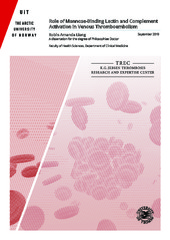Sammendrag
The complement and coagulation systems are two interrelated plasma protein cascades. Evidence from observational and animal studies has proposed a role for the complement system in the development of venous thromboembolism (VTE), but the exact mechanisms remain obscure.
The aim of this thesis was to investigate whether activation of the complement system impacts the risk of VTE and to investigate which pathways may be involved. The procoagulant properties of the lectin pathway, in particular, demanded closer inspection. Genetic variations associated with plasma levels of complement protein or activation products were also explored to discover novel genetic regulators that could potentially contribute to thrombosis risk.
The fourth survey of the Tromsø Study was used as the parent cohort for all of the nested case-control studies discussed in this thesis. There were 462 individuals who experienced a VTE in the follow-up period (1994/95-2007). For each VTE case, two age- and sex-matched controls who were alive at the index date of the VTE event were randomly sampled from the source cohort.
The findings in this thesis support a role for the complement system in the development of VTE. Higher baseline levels of complement activation as measured by the soluble terminal C5b-9 complement complex (TCC) were associated with future risk of VTE, as were high levels of plasma mannose-binding lectin (MBL). The rs8176719 SNP of the ABO gene, which determines O and non-O blood types and is itself a known risk factor for VTE, was found to be significantly associated with high plasma MBL levels. Individuals with high plasma MBL levels and type O blood were found to have a similar risk for VTE as individuals with non-O blood type, regardless of plasma MBL levels.
These studies implicate that the lectin pathway is involved in the mechanisms leading to venous thrombosis. Functional studies are warranted. Additionally, the discovery of a relationship between blood type and plasma MBL levels requires further investigation, both alone and as a risk factor for venous thromboembolism.
Har del(er)
Paper I: Høiland, I.I., Liang, R.A., Brækkan, S.K., Pettersen, K., Ludviksen, J.K., Latysheva, N., … Hansen, J.B. (2019). Complement Activation Assessed by the Plasma Terminal Complement Complex and Future Risk of Venous Thromboembolism. Journal of Thrombosis and Haemostasis, 17(6), 934-943. Also available at https://doi.org/10.1111/jth.14438.
Paper II: Liang, R.A., Høiland, I.I., Ueland, T., Aukrust, P., Snir, O., Hindberg, K., … Hansen, J.B. (2019). Plasma levels of Mannose-Binding Lectin and Future Risk of Venous Thromboembolism. Journal of Thrombosis and Haemostasis, 17(10), 1661-1669. Also available in Munin at https://hdl.handle.net/10037/16191.
Paper III: Liang, R.A., Hindberg, K., Ueland, T., Aukrust, P., Snir, O., Brækkan, S.K., … Hansen, J.B. ABO Status Affects Plasma Mannose-Binding Lectin Levels and the Association Between MBL Levels and Risk of Venous Thromboembolism. (Manuscript). Available in the file “thesis_entire.pdf”.


 English
English norsk
norsk
